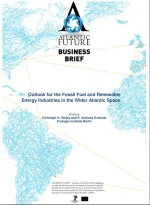Outlook for the Fossil Fuel and Renewable Energy Industries in the Wider Atlantic Space

Business Brief
Although, the Atlantic Space holds a large share of the world’s unexploited fossil fuel reserves, including 40% of oil reserves, 20% of natural gas reserves, and roughly 40% of coal reserves (BP 2015), the future of the industry is uncertain. Large profit margins (in the past) and continued subsides have made some of these unconventional and difficult hydrocarbon reserves easier to access via new technologies, particularly in the cases of the North Atlantic shale revolution and the Southern Atlantic “oil ring” ( Isbell 2014). In the North Atlantic, shale gas now accounts for more than 35% of American gas production, compared to 2% in 2000. Demand for shale oil and gas is predicted to
rise from 1.96 BCM/day to 2.69 BCM/day by 2035 (Szalai 2013). In the Southern Atlantic oil ring, deep-water offshore oil rigs now span from Namibia and Morocco in the east to Argentina and the Gulf of Mexico (Isbell 2014), but their further expansion is in doubt given current and projected oil prices.
Yet since early 2014, doubts about the future of the fossil industry have grown. Recent price levels have undermined the expectation of future profits from new exploration and field development, while also reducing the profitability of existing extraction. The fossil fuel industry used to and currently still continues to reap most of the monetary benefits of the rising energy demand. Lower prices, however, erode the profitability of the sector, and stock market valuations have declined.
Conversely, the renewable energy sector keeps growing, in spite of falling fossil prices, albeit at a somewhat reduced pace. Over 70% of the global installed renewable energy capacity is held in the Atlantic Space.